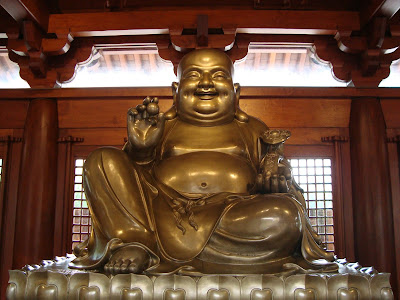"There is no truth, only points of view"
(variously attrib. - among others, to Edith Sitwell)
I hear this one a lot in my job. When you're suggesting a particular reading of a literary text to a class of stroppy students, it's definitely a point you have to consider. So,
is truth entirely a matter of interpretation, of the historical and political circumstances of the observer? There are certainly many reasons for suspecting as much.
“Nietzsche said that truth was the most profound lie. Canguilhem ... would say perhaps that on the enormous calendar of life, it is the most recent error ...”
(Michel Foucault, Introduction to Georges Canquilhem's The Normal and the Pathological).
Presumably what Foucault meant here was to denounce the idea of "truth" as a blazing beacon of certitude: a kind of immanent category which transcends all others. It's not quite the same thing as the statement above, therefore.
The way I prefer to approach the word "truth" is by means of a question: Do you recognise the existence of error? In other words, is a misreading a possibility for you? For instance, if you were to read out a passage in a foreign language unknown to you, and then make guesses at the meaning of some of the words, would this be a legitimate "interpretation" of the passage - or simply a manifestation of ignorance?
I remember once reading a library book which contained a number of quotations in Italian. A previous reader had gone through these painstakingly translating them word by word. In almost every case he or she had got them quite wrong. The idiomatic significance of phrases in Italian is not easily deducible from the individual words which make them up. Having studied the language for a few years, I was able to see that.
Take, for instance, an English colloquialism such as "we stuffed up." "
We" is easy enough to understand. The verb "
to stuff" is a bit more problematic, but at least the past perfect ending "
ed" tells us that it
is a verb. Nor is the preposition "
up" unusual. And yet a literal translation of these three words would get you nowhere near the meaning of the phrase
for the people using it.
I emphasise those last words because they are crucial: the "interpretative community" for the phrase (to borrow a term from lit crit) consists of - people familiar with English slang.
To be sure, a more advanced student of English would know of the existence of phrasal verbs: verbs which take on a particular meaning when a preposition is added to them. In this case, then, "stuff up" means something different from "stuff around" or "stuff about," and something different again from "stuff it."
But would such a student know that this is not a "nice" thing to say: that it would be unwise to use such a phrase in a formal context? Probably not. Whereas saying "it knocked the stuffing out of me" is much more innocuous. Why? Who can say? it's something you have to learn, painstakingly, if you want to understand - let alone speak - a foreign language.
Of course, there's nothing to stop you adopting a Humpty-Dumpty attitude, and simply ordering words to do what you tell them. In that case you can say whatever you please, however you want to. You'll probably sound a bit like that whether you want to or not when you first start to try to communicate in the new language you've been studying. Claiming that your Italian (or Chinese, or French) is every bit as valid as that of people who can function in that society, though, is pretty fatuous.
There's a gag I read once in a British magazine about literary receptions abroad, the ones where someone comes up to you and says, "Hello, I your English translator am!" So, no, I'm unable to concur with the view that all truths are relative, and all interpretations equal.
My Italian may be better than that of the anonymous annotator of that book, but it's still not very good. I've never lived in the country, and struggling through a novel or two in the language is a lot easier than conducting a coherent conversation.
So what the heck and the hey has all this got to do with
Room 237? What
is Room 237, anyway? Well, it's a 2012 documentary which strings together four fairly complex readings of Stanley Kubrick's classic 1980 horror film
The Shining (based on the equally famous 1977 Stephen King
novel).
And why is this of interest? Well, for a start it reveals the existence of a whole subculture of obsessives who examine films frame by frame for their "inner" meanings, and in the process reveal at least as many interesting things about themselves as about their ostensible subject matter: in this case the "Master," Kubrick himself.
The most famous of these readings is probably the one that reveals the film to be an extensive confession to SK's role in faking the moon landings. The child Danny wears a knitted jumper with the word "Apollo" on it, together with a picture of a rocket, and there a number of other significant clues to Kubrick's manifest guilt about this monstrous assault on truth.
That one's quite fun. But then there's another reading which reveals the film to be about the massacre of Native Americans (lots of "Indian" artefacts and imagery throughout the film). And then there's another one which reveals the film to be about the Holocaust (a subject which greatly interested Kubrick, and which he did apparently plan to make a feature film about). The important detail here is the Adler typewriter Jack Torrance (played by Jack Nicholson) is writing his play on, and also the "disappearance" of various items from the room from shot to shot.
There's also an interesting reading which hinges on Jack Torrance as the Minotaur and the Overlook hotel as a labyrinth, which includes a fascinating analysis of the illogical placing of the rooms on each floor, and the impossibility of constructing a consistent floorplan from the information given.
This is a very bald summary of some richly particular readings, but I think it gives you some idea of a very few of the many, many interpretations this film has given rise to over the years (but particularly since the advent of DVD, which has enabled researchers to dwell on particular details for unlimited periods of time).
Why? What is about this film which so obsesses people? Could the same process be enacted with
any film? No doubt it could be: with any "auteurist" film, at any rate. None of the interpreters go beyond a basic position of authorial intention in their readings of the collaborative artefact that is a contemporary feature film. All four of them take for granted that Kubrick's notorious perfectionism and obsessive attention to detail justify their own minute analyses of the
mise en scène of particular scenes.
Nor do any of these readings really overlap with the others. Each makes a global claim for the correctness of their hypothesis. They don't claim to detect subtexts or subsidiary themes, but rather - in each case - the overall significance of the film. If one interpretation were ever to be proved "correct" - for example if a diary entry were to be found where Kubrick
confessed to faking the moon landings, or for filling his film with Holocaust imagery - then the others would automatically fall by the wayside.
So what does Big Steve think?
Well, in his 2014 piece entitled "
Why Stephen King Is Utterly Wrong About 'Room 237'," Sam Adams quotes the following passage from an interview with the Master:
Did you see that new documentary Room "237" about obsessive fans of Stanley Kubrick’s "The Shining"?
Yeah. Well, let me put it this way – I watched about half of it and got sort of impatient with it and turned it off.
Why?
These guys were reaching. I’ve never had much patience for academic bullshit. It’s like Dylan says, “You give people a lot of knives and forks, they’ve gotta cut something.” And that was what was going on in that movie.
This is very much in accord with the view expressed by King in his 1981 book on the Horror genre,
Danse Macabre: “I shy away from the aroma of grad school analysis like a horse sensing alkali in bad water." Who can argue with that?
Well, Sam Adams can, for one. He points out that:
What’s frustrating about King’s remarks is that he walks right up to the edge of understanding before storming up in a huff. His Dylan paraphrase about knives and forks is on the money: "Room 237" is indeed about the indiscriminate application of analytical tools, which is what happens when film criticism is practiced without self-criticism.
He goes on to say: "In discussing what "Room 237" is
really about, one runs the risk, of course, of sounding perilously like one of the movie’s subjects, but that’s just one more way in which it functions, brilliantly, as a kind of recursive Rorschach test." A test revealing what? Why, the degree of "madness" in each critic's own reading:
In poring over still images, like the purported picture of a minotaur or the Dopey sticker on Danny’s door, they effectively thwart the film’s forward motion, ignoring its obsessively crafted text to construct their own, often unrelated meanings.
Like Balzac's
Chef d'oeuvre inconnu, then, Adams sees
Room 237 as a fable for critics, a valuable corrective to their own tendency to stack the evidence in favour of their own hypotheses, without applying the acid test of
falsifiability (in Karl Popper's terms, as in his 1959 classic
The Logic of Scientific Discovery).
I have to admit, Adams has a point.
The Shining is, after all, a magnificent movie, one which continues to reveal fresh subtleties each time it's watched (one thing that interested me about the four interpretations included in
Room 237 is that not one of them paid the slightest attention to the condition of the artefact: not just the considerations of lighting and aperture which so obsessed Kubrick, as the fact that the film
exists in two versions. The "international cut" is approximately half an hour shorter than the American cut, an anomaly which Kubrick made no attempt to correct. Having watched both of them, I can say that beyond a scene where Wendy and Danny are watching a TV set which does not appear to be plugged in, there's little to preoccupy the casual viewer in the longer version, but how allegedly serious critics can continue to overlook such questions continues to stagger me).
I"m not sure that Big Steve isn't right, too, though. One of the great things about the DVD version of
Room 237 is the extras, including a fascinating debate between (among others) the documentary director and one of Kubrick's production assistants. The latter is, admittedly, a little too prone to attribute any and all strangenesses in the film to "Stanley's way of working" - but it takes a certain amount of
chutzpah to discount such information sight unseen: almost the equivalent, in fact, as trying to translate from a language without learning it first.
We learn, for example, of Stanley's concern for arranging his scenes as stills - visually meaningful glimpses, rather than internally consistent layouts. Where Roberto Rossellini, for instance, would put period clothes in the (unopened) drawers of the furniture in his lovingly constructed sets, Kubrick was all about moment by moment effects. He may have spent months agonising over the precise doorknob to use in a scene lasting a microsecond, but that was because of how it
looked, not what it stood for symbolically.
Such statements are in themselves (of course) interpretative. The experience of a production assistant would not be that of a script collaborator, or, for that matter, an actor - but it's interesting data, nevertheless. It acknowledges the existence of a complex
outside world endlessly interfering - or helping - with that work of art we, as critics, work so hard to isolate, as if in a vacuum sealed room.
It is impossible to master a foreign language to such an degree to make you indistinguishable from a native speaker of that language. There are cases, admittedly - Joseph Conrad, Vladimir Nabokov - where a "foreigner's" command of English is greatly
superior to almost any native speaker one cares to name. It's not quite the
same, though, nevertheless.
For that matter, no two people's command of their
own language is precisely equivalent, let alone "complete." We all get things wrong, tangle up our syntax, forget the meanings of words. In this sense, then, the search for an absolute truth is a little like the attempt to express yourself in some transcendent language seamless with reality: to speak of things exactly as they are. Obviously, it can't be done.
But that's not to say that
absolute ignorance of both grammar and vocabulary can ever be an acceptable preparation for attempting to express yourself in a particular tongue.
I wouldn't accuse the theorists of Room 237 of absolute ignorance. Each of them is roughly acquainted with basic facts of Stanley Kubrick's biography, and many seem to wish to extend their theorising to some of his other films, also. When it comes to basic difficulties with the concept of "authorial intention" - let alone the technicalities of critiquing a collaborative text such as a studio-released feature film - they reveal such simplistic attitudes, however, that it's hard to take any of their contentions seriously.
A fable for critics then, yes, definitely. Anyone who watches
Room 237 and thinks that "there's a lot in it," or that one or two of them come pretty close to proving their point, has clearly not gone very far in their study of the grammar of interpretation.
But Big Steve is right, too. You don't need a chemical analysis of its structure to know that alkali is not a good thing to find in water.









































































